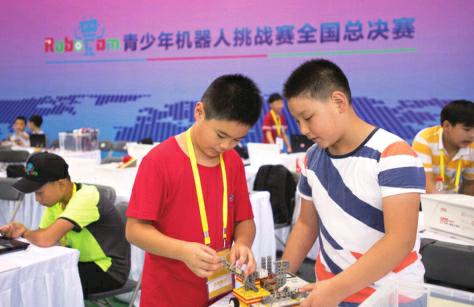Handiwork Lesson
2017-08-10
A student from Britains Princes School of Traditional Arts learns woodblock printing from Wei Lizhong, an inheritor of the centuries-old technique, at a training session in Hangzhou, east Chinas Zhejiang Province, on July 25. Woodblock printing has been listed as an intangible cultural heritage by the Chinese Government.
Disaster Recovery
The Chinese Government has increased the recovery fund for natural disasters this year, the Ministry of Civil Affairs said on July 25.
The recovery fund is currently almost twice as large as before, said Pang Chenmin, head of the ministrys Disaster Relief Bureau, at a press conference.
In 2017, the Chinese Government spent nearly 1.2 billion yuan ($177 million) on recovery work after natural disasters.
In an executive meeting in May, the State Council, Chinas cabinet, decided to raise the subsidy for emergency assistance efforts in natural disasters, the pension for family members of those killed in major disasters, the life assistance fund in the transitional period, and the central government subsidy for restoring and rebuilding damaged residential buildings.
Pang said there were 142,000 damaged residential buildings that needed to be rebuilt in 2016, and 93.2 percent of the rebuilding work has been fi nished so far.
The ministry will work with other departments and send supervision teams to make sure the outstanding rebuilding work can be completed in 2017.
Yangtze Plan
An environmental protection plan covering the Yangtze River Economic Belt has been unveiled as the latest move to protect Chinas longest waterway from pollution.
The plan was jointly released by the Ministry of Environmental Protection, the National Development and Reform Commission and the Ministry of Water Resources.
It places an upper limit on the usage of water resources along the belt, said Zhao Yingmin, Vice Minister of Environmental Protection.
An ecological red line will be put in place to protect and restore the surrounding environment of key areas, Zhao said.
This is in line with government guidelines issued earlier this year on a nationwide ecological red line strategy that will place certain regions under mandatory and rigorous protection.
Water quality management will be based on a bottom line system to strengthen controls on pollution along the belt, especially for drinking water sources, according to Zhao.
The plan also demands improved responses to environmental emergencies and closer regional coordination.
Stretching from Yunnan Province in the southwest to Shanghai, the Yangtze River Economic Belt covers nine provinces and two municipalities in an area of 2.05 million square km. It accounts for more than 40 percent of the countrys population and economic aggregate.
In 2014, China made developing the economic belt a national strategy. The move was expected to boost development in riverside regions and provide new growth stimuli for the economy.
Research Network
China will strengthen the establishment of national clinical research centers, according to the Ministry of Science and Technology.
A total of 32 national clinical research centers, covering 11 disease categories such as cardiovascular system, malignant tumor and respiratory system, were given licenses at a national conference in Beijing on July 22.
A development program, a set of guidelines and an assessment plan for national clinical research centers were released at the conference.
According to Vice Minister Wang Zhigang, national clinical research centers should take on the main responsibility in linking clinical medicine with life sciences and biotechnology research and applying clinical research in practice.
National clinical research centers will be located at 30 top hospitals and more than 2,100 medical institutions.
Geothermal Discovery
Two geothermal fi elds have been identifi ed on the Pamir Plateau in northwest Chinas Xinjiang Uygur Autonomous Region after an eightyear survey.
One f eild at Quman Village in Taxkorgan Tajik Autonomous County, covers 8 square km, said Wang Hong, deputy chief engineer of Xinjiangs Department of Land and Resources.
“Analyses of geological structure, temperature and pressure show that the Quman fi eld can promise stable yields for more than 100 years,” Wang said.
Geothermal resources are generally used for heating water and greenhouses and generating electricity.
Another fi eld covering 7 square km of low-temperature geothermal resources was also found in the county, suitable for hot spring therapy and leisure pursuits.
Taxkorgan on the Pamir Plateau endures long, harsh winters. The cost of coal-fi red heating has always been a heavy burden for local residents.
In 2010, Xinjiang began to explore geothermal resources in Taxkorgan, spending 48 million yuan ($7 million) on the search.
Researchers estimate that the Quman fi eld could provide heating for 12,000 residents, reducing heating cost by 30 million yuan ($4.44 million) each year.
Green Alliance
A green manufacturing alliance was inaugurated on July 22 to better support Chinas green and sustainable development, according to the Ministry of Industry and Information Technology (MIIT).
Led by the ministry, members of the Green Manufacturing Association of China are from leading scientifi c research institutions and manufacturing enterprises, covering such industries as iron and steel, building materials, energy, textiles and fi nance.
According to the ministry, the alliance will serve as a platform for Chinas green manufacturing businesses to cooperate with fi nancial institutions and multinational enterprises.
IP Protection
Shanghais fi rst intellectual property protection center was set up on July 25 in the citys Pudong New District.
The center will launch a service to enable faster examination of patents and decrease the authorization time to less than 15 months from the original 30 months, said Lu Guoqiang, Director General of the Shanghai Intellectual Property Administration.
Pudong is home to burgeoning high-end equipment manufacturing and bio-pharmaceutical industries, where demand for intellectual property rights service is high.
In 2016, the enterprises in Pudong fi led more than 9,500 patent applications in the high-end equipment manufacturing industry and 2,300 in the bio-pharmaceutical industry.
A complaint channel will also be launched to investigate suspected infringements of patents, trademarks and copyrights.
The center will work with Shanghai intellectual property court to enhance intellectual property rights protection.
Farmland Survey
Chinas total farmland area dropped slightly in 2016, while the amount of construction land went up, offi cial data showed on July 22.
At the end of 2016, China had a total of 2.024 billion mu (135 million hectares) of farmland, down 1.153 million mu (76,867 hectares) from the 2015 level, according to a survey by the Ministry of Land and Resources.
Meanwhile, an extra 8.09 million mu (539,333 hectares) of land was set aside for construction in 2016, up 4.4 percent year on year, a large part of which will be used for infrastructure construction, said the ministry.
In 2016, the amount of new land used for highway and railway construction rose 30.7 percent and 102.8 percent, respectively, from a year ago.
China must retain at least 1.865 billion mu (124 million hectares) of farmland by 2020, under a new target set by the ministry in 2016, which is above a government red line of 1.8 billion mu (120 million hectares).
History Maker
Xu Jiayu celebrates at the awards ceremony of the mens 100m backstroke event at the 17th FINA World Championships in Budapest, Hungary, on July 25. He won Chinas fi rst gold medal ever in the event with a time of 52.44 seconds.
Skill Competition
Contestants adjust their robot during the national fi nal of the RoboCom Adolescents Challenge of the World Robot Contest 2017 in Wuhan, central Chinas Hubei Province, on July 24.
Forecast Revised
The International Monetary Fund(IMF) on July 24 revised up its growth forecasts for China in 2017 and 2018 to 6.7 percent and 6.4 percent respectively.
The updated World Economic Outlook report, which came days after China posted a strongerthan-expected second quarterly performance, was a refl ection of a solid fi rst quarter underpinned by previous policy easing and supplyside reforms, including efforts to reduce excess capacity in the industrial sector, the IMF said.
But the IMF also warned against strong credit growth that may come with rising downside risks to medium-term growth.
Maurice Obstfeld, chief economist of the IMF, recommended China go through a rebalancing process, which will inevitably entail a slowed growth path. He said Chinas recent moves to redress non-performing loans and a coordinated fi nancial oversight overhaul are welcome.
Deep Sea Exploration
Chinas self-developed underwater robot Tansuo on its fi rst experimental operation in the South China Sea on July 24.
The robot conducted its maiden test dive and had 20 hours of collaborative operations with the unmanned submersible Faxian.
Stability Stressed
China will continue “seeking progress while maintaining stability” for its economic work in the second half of 2017, according to a meeting of the Political Bureau of the Communist Party of China Central Committee on July 24.
The meeting stressed that a proactive fi scal policy and prudent monetary policy with supply-side structural reform as the main theme will be implemented in the latter half of the year.
Authorities will maintain the continuity and consistency of policies to ensure sound and stable economic growth, push forward supply-side structural reform and guard against systemic fi nancial risks, according to a statement released after the meeting.
The meeting pledged fi rm measures to push for progresses on excess capacity cuts, inventory reduction, deleveraging, relieving corporate burdens and fi xing weak links, and more efforts to deal with“zombie enterprises,” or unprofi table fi rms burdened by debt, mismanagement or overcapacity.
Didi Invests in Grab
Didi Chuxing, Chinas biggest ridehailing company, announced on July 24 that it will cooperate with Japanese telecom company SoftBank Group Corp. to invest $2 billion in Grab, Ubers biggest rival in Southeast Asia.
The deal—Didis latest push to expand its overseas infl uence—is expected to help Grab grow local market shares, while Uber is facing a bunch of challenges in the United States, including accusations of a sexist work culture as well as driver protests.
Anthony Tan, Group CEO and co-founder of Grab, said the new capital would also be used to accelerate the application of its GrabPay mobile payment service in Southeast Asia.
Grab is now available in 65 cities across seven countries in the region, giving local consumers access to over 1.1 million drivers who offer private cars, motorbikes, taxis, carpooling and other services. It said that it holds a 95-percent market share in third-party taxi-hailing and 71 percent in private vehicle hailing.
Didi said it has established a network of partnerships reaching over 50 percent of the worlds population across more than 1,000 cities in North America, Southeast Asia, South Asia and South America.
Global Rankings
Chinese fi rms continue to ascend global rankings as their competitiveness grows with the transitioning economy. The Fortune Global 500 list is seeing a China boom this year, the magazine said on its website.
Chinese f rims f liled an unprec- edented 115 places on the 2017 list, only 17 less than the top performer, the United States, and marking the 14th year China has increased its presence on the list.
The Chinese companies making the list were mainly involved in the Internet, retail, fi nance, energy and property sectors.
U.S. retail giant Wal-Mart topped the list. Chinas State Grid and oil giant Sinopec Corp. were second and third, with revenue reaching $315 billion and $268 billion, respectively, in 2016.
Chinese telecom giant Huawei rose from the 129th position last year to 83rd this year, beating all global peers in its sector.
Another bright spot is the rise of private companies. Ten Chinese fi rms hit the list for the fi rst time, most of them private companies, including Alibaba and Tencent.
